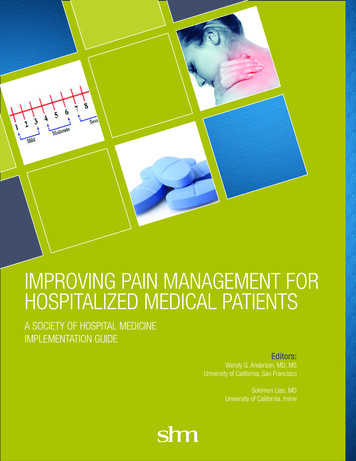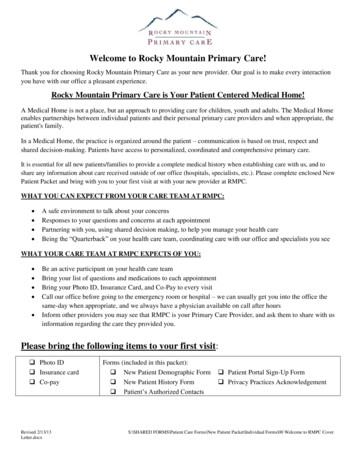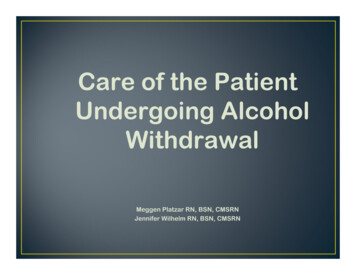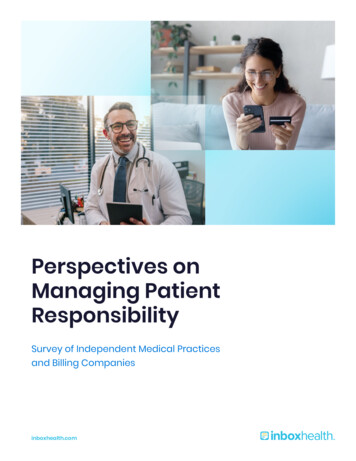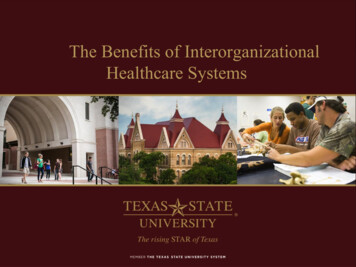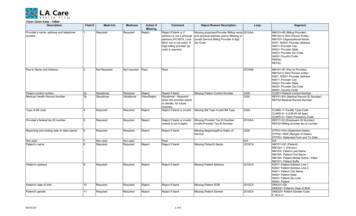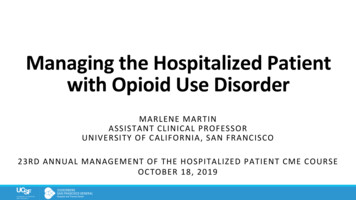
Transcription
Managing the Hospitalized Patientwith Opioid Use DisorderMARLENE MARTINASSISTANT CLINICAL PROFESSORUNIVERSITY OF CALIFORNIA, SAN FRANCISCO23RD ANNUAL MANAGEMENT OF THE HOSPITALIZED PATIENT CME COURSEOCTOBER 18, 2019
35 Y man admitted overnight with right upperextremity erythema, pain, and swelling Started on empiric treatment for cellulitis You are getting sign out from your overnight colleague when you get pagedthat he is complaining of diarrhea, abdominal pain, headache, and nausea You evaluate the patient and note he is yawning and that his pupils aredilated. He endorses last using heroin before being admitted
Objectives1.2.3.Diagnose and treat opioid withdrawal and opioiduse disorder (OUD) with either methadone orbuprenorphineRecognize how to link hospitalized patients tobuprenorphine or methadone treatment ondischargeName three options for OUD harm reduction
Outlineq Prevalence, demographics, and characteristicsof hospitalized patients with OUDq Diagnosing OUDq Medication treatmentq Cases
Three Waves of Opioid Overdose DeathsSource: CDC, 2017
OUD-relatedhospitalizationsand ED visitsalmost doubledin the lastdecadeSource: AHRQ, 2017
SUD among hospitalized patientso Up to 25% of hospitalized patientso More likely to be admitted from the emergency departmento Longer lengths of stay, costlier, higher readmissiono High AMA rateso Lowest quartile of incomeo Unconnected to careStatistical Brief #249. Healthcare Cost and Utilization Project (HCUP). March 2019. Agency for Healthcare Research and Quality, Rockville, MD.Brown RL, Leonard T, Saunders LA et al. The prevalence and detection of substance use disorders among inpatients ages 18 to 49: an opportunity for prevention. Prev Med 1998; 27 (1): 101-10).Englander H, Weimer M, Solotaroff R et al. Planning and Designing the Improving Addiction Care Team (IMPACT) for Hospitalized Adults with Substance Use Disorder. J Hosp Med. 2017 May;12(5):339-342.Spooner, K.K., Salemi, J.L., Salihu, H.M., Zoorob, R.J., 2017. Discharge against medical advice in the United States, 2002-2011. Mayo Clin. Proc. 92, 525–535.Walley AY, Paasche-Orlow M, Lee EC, et al. Acute care hospital utilization among medical inpatients discharged with a substance use disorder diagnosis. J Addict Med. 2012 Mar;6(1):50-6.Ronan MV and Herzig SJ. Hospitalizations Related To Opioid Abuse/Dependence And Associated Serious Infections Increased Sharply, 2002-12. Health Aff (Millwood). 2016 May 1;35(5):832-7.
Why treat OUD in the hospital?o Eliminate withdrawal and reduce cravingso If return to use while on treatment occurs, less/no higho Maintain toleranceo Root cause of ED visits, admissions, and readmissionso Patients motivated to cut back or stop use – pivotal touch pointoooooWhen addressed:Improved rates of PCP and addiction treatment follow upReduced substance use after dischargeLower 30-day readmissionsImproved patient and provider experiencesVelez CM, Nicolaidis C, Korthuis PT, Englander H. "It's been an Experience, a Life Learning Experience": A Qualitative Study of Hospitalized Patients with Substance Use Disorders. J Gen Intern Med. 2017 Mar;32(3):296-303.Wei J, Defries T, Lozada M, Young N, Huen W, Tulsky J. An inpatient treatment and discharge planning protocol for alcohol dependence: efficacy in reducing 30-day readmissions and emergency department visits. J Gen Intern Med. 2015 Mar;30(3):365-70.Englander H, Collins D, Perry SP et al. "We've Learned It's a Medical Illness, Not a Moral Choice": Qualitative Study of the Effects of a Multicomponent Addiction Intervention on Hospital Providers' Attitudes and Experiences. J Hosp Med. 2018 Nov 1;13(11):752-758.Englander H, Weimer M, Solotaroff R et al. Planning and Designing the Improving Addiction Care Team (IMPACT) for Hospitlaized Adults with Substance Use Disorder. J Hosp Med. 2017 May; 12(5):339-342.Liebschutz JM, Crooks D, Herman D. Buprenorphine treatment for hospitalized, opioid-dependent patients: a randomized clinical trial. JAMA Intern Med. 2014 Aug;174(8):1369-76.
Outlineq Prevalence, demographics, and characteristicsof hospitalized patients with OUDq Diagnosing OUDq Medication treatmentq Cases
Diagnosing OUDSymptoms WithdrawalUncontrolled painDiagnoses Skin and soft tissue infectionsEndocarditis, osteomyelitisTraumaOverdoseDSM Criteria Chronic painNot all who use opioids have OUD
Control: Exceeded own limitsFailed attempts to quit/control useImpaired ControlCompulsion: Time using, getting, recoveringCravingRole failureConsequences: Relationship troubleSocial ImpairmentGave up other meaningful activitiesRisk of bodily harmPhysical/psychological consequencesRisky UseTolerancePharmacological CriteriaWithdrawal
Outlineq Prevalence, demographics, and characteristicsof hospitalized patients with OUDq Diagnosing OUDq Medication treatmentq Cases
Medications for OUDYOpioids: full agonistheroin, oxycodone, fentanyl, etcYYMethadone: full agonistActivates receptorYExtended-release naltrexone, naloxone:Full antagonist, high affinityßMu receptorBuprenorphine: partial agonistHigh affinity, ceiling effect
Medications for OUDMethadoneBuprenorphineTreatment retentionHigher than buprenorphineRetention improves at doses 16mgOffice visitsDaily visits to treatment programDaily-monthly; can also provide as DOT in somesettingsWho can prescribe in acutecare?Any inpatient provider during hospitalization.Any provider in ED: up to 72 hours dosingAny inpatient provider during hospitalization.Any provider in ED: up to 72 hours dosingWho can prescribe atdischarge?Opiate Treatment Program (methadone clinic)Any provider with DATA2000 X waiverSedationYes at high doses, non-tolerant patients or slowmetabolizersCeiling effect for respiratory depressionWithdrawal when startingTakes time to reach comfortable doseNeed to be in withdrawal
Buprenorphine: precipitated withdrawalo Must be in withdrawal prior toinductiono High affinityHeroinBuprenorphineYYJL
Decreased MortalityAll cause mortality per 1000 person years40.30.20.10.0.In methadoneOut of methadoneIn buprenorphine Out of buprenorphineSource: Sordo et al, BMJ, 2017
Hospital Initiation of Buprenorphine% Patients8072 %Detox80647060605040200403012 %207100Days in bup over 6 monthsSource: Liebschutz et al, JAMA Internal Medicine, 2014Number of DaysMaintenance
Detox Doesn’t LastSource: Chutuape M et al, The American Journal of Drug and Alcohol Abuse, 2001.
Outlineq Prevalence, demographics, and characteristicsof hospitalized patients with OUDq Diagnosing OUDq Medication treatmentq Cases
*Uncomplicated no methadone for 5days, no acute pain or surgery, notaltered, no severe illness**If concerned for precipitatedwithdrawal, start with 2mgDay 1Methadone Guide for OUD Treatmentand WithdrawalqUtox, pregnancy test, consider QTc,CURES, COWS, confirm OUDqGive 20mg methadoneqEvery 4 hours - COWS, if havingcravings or withdrawal, give 10mg more.Do not exceed 40mgqGive total Day 1 dose in amqEvery 4 hours - COWS, if havingcravings or withdrawal, give 10mg more.Do not exceed 50mgqGive total Day 2 dose in am and followsame protocol. Do not exceed 60mgqGive Day 3 max dose. Continue protocoluntil reaching 60mg daily. Then hold for5 days before increasing by 10mg every5 daysDay 2Day 43Day 2Day 1Opioid Use Disorder (OUD), Opioid Withdrawal, and Linkage to TreatmentBuprenorphine Guide for OUDTreatment and *UncomplicatedWithdrawalqUtox, pregnancy test, CURES, COWS,confirm OUD, consider QTc & LFTsqStart buprenorphine (bup) when mildwithdrawal (COWS 8) or no opioids for5 days. If received opioids:qShort actingà wait 12 hrsqLong actingà wait 24-48 hrsqMethadone in last 5 daysà requesthelpqGive **bup 4-8mg (ensure sublingual)q1 hour later à recheck COWS. If 8give 4mg moreq6 hours later (sooner if withdrawing) àrecheck COWS. If 8 give 4mg. Maxdose 16mg on Day 1qGive total Day 1 dose in am. TID dosingif patient has painq1 hour later à if having cravings, pain,or withdrawal increase total daily doseby 4-8mgqGoal daily dose 16-24mg/day. Ifgreater, request helpAdjunctive SupportClonidine 0.1-0.3 mg PO q6-8 hours PRN(NTE 1.2 mg/day) à Sweating,restlessness, hot flashes, watery eyes,anxietyLoperamide 4 mg PO x 1, then 2 mg PRN(NTE 16 mg/24 hours) à Loose stoolsZofran 4 mg PO q 6 hours PRN à NauseaTrazodone or Melatonin à InsomniaDiphenhydramine 25-50 mg, PO q 8 hoursPRN à Insomnia or anxietyTylenol and/or Ibuprofen 650 mg PO q 6hours PRN à PainBup and Methadone Quick Facts Inpatient providers can order bup ormethadone for OUD, opioid withdrawal, orto continue outpatient tx X-waivered providers can prescribe bupon discharge Inpatient providers cannot prescribemethadone for OUD on discharge
Case 145-year-old man with a history of injection heroin use is admittedwith cellulitis of his right upper extremity.Two hours after admission, he feels achy and nauseous. His pulse is102, he is sweating, and moving frequently in bed. Assume his sepsisis adequately addressed, and his symptoms are from opioidwithdrawal. What medications would you offer him?How would you decide when to start these medications?How would you dose these medications?What do you do with his OUD medications at discharge?
Buprenorphineq COWS 8, Must be in withdrawal prior to inductionq Initial dose 8-12h after short acting, 24-48h post long actingq Transitioning from methadone—ask for help
BuprenorphineWhen COWS 8, give 4-8 mgMax day 1: 16 mgIncrease dose: craving, withdrawal,painMax day 2: 24 mgDecrease dose: insomnia/mania,sedationTherapeutic dose 16-24mg/dayPrecipitated withdrawal: morebuprenorphine OR short acting fullagonist
Withdrawal AssessmentCOWS shortcut: Subjective symptomsAND at least 1 objective withdrawal sign Subjective: Nausea, abdominal pain,myalgias, chills Objective (at least 1): Restlessness,sweating, rhinorrhea, dilated pupils,watery eyes, tachycardia, yawning,goose bumps, vomiting, diarrhea,tremor
MethadoneDay 1Start with 10-30 mg, reassess in 3-4 hrs, may add 10mg PRN w/d sx, max 40 mgDocument COWS, sedation scores @ 0 min, 4 h. Goal COWS 5Day 2Total Day 1 5-10 mg PRN, max 50 mgDay 3Today Day 2 5-10 mg PRN, max 60 mgMonitor on 60mg daily for 5 days before increasing again by 5-10mg, then holdthat dose for 5 days, etcTarget daily dose 80-120mg
MethadoneRisk of overdosewith inductionPeak3-4hoursSteady state:3-7 daysHalf life:24-36 hoursDays at steady dose
Medication Care TransitionStart medication in the acutesetting and communicate withPCP or OTP!BuprenorphinePrescribe at d/c if waiveredand bridge to outpatient planMethadoneCannot prescribe ondischarge for OUDOpioid Treatment ProgramPartner with local methadoneclinicBridge ClinicTelemedicinePrimary CareOTP(Some carry bup)(SAMHSA website listswaivered providers)
Case 260-year-old woman with a history of tricuspid valve endocarditis andanxiety is admitted for acute encephalopathy. Urine toxicology showsmorphine, alprazolam, and cocaine. Shortly after admission, she wakesup sweating, tremulous, agitated, and vomiting and is asking to leave.Assume her symptoms are from opioid withdrawal. What medications would you offer for her withdrawal if she doesnot want to continue OUD treatment after discharge? What harm reduction measures would you provide if she isinterested in treating the OUD but not stopping benzos or cocaine? What bloodwork could you obtain to look for complications ofOUD?
*Uncomplicated no methadone for 5days, no acute pain or surgery, notaltered, no severe illness**If concerned for precipitatedwithdrawal, start with 2mgDay 1Methadone Guide for OUD Treatmentand WithdrawalqUtox, pregnancy test, consider QTc,CURES, COWS, confirm OUDqGive 20mg methadoneqEvery 4 hours - COWS, if havingcravings or withdrawal, give 10mg more.Do not exceed 40mgqGive total Day 1 dose in amqEvery 4 hours - COWS, if havingcravings or withdrawal, give 10mg more.Do not exceed 50mgqGive total Day 2 dose in am and followsame protocol. Do not exceed 60mgqGive Day 3 max dose. Continue protocoluntil reaching 60mg daily. Then hold for5 days before increasing by 10mg every5 daysDay 2Day 43Day 2Day 1Opioid Use Disorder (OUD), Opioid Withdrawal, and Linkage to TreatmentBuprenorphine Guide for OUDTreatment and *UncomplicatedWithdrawalqUtox, pregnancy test, CURES, COWS,confirm OUD, consider QTc & LFTsqStart buprenorphine (bup) when mildwithdrawal (COWS 8) or no opioids for5 days. If received opioids:qShort actingà wait 12 hrsqLong actingà wait 24-48 hrsqMethadone in last 5 daysà requesthelpqGive **bup 4-8mg (ensure sublingual)q1 hour later à recheck COWS. If 8give 4mg moreq6 hours later (sooner if withdrawing) àrecheck COWS. If 8 give 4mg. Maxdose 16mg on Day 1qGive total Day 1 dose in am. TID dosingif patient has painq1 hour later à if having cravings, pain,or withdrawal increase total daily doseby 4-8mgqGoal daily dose 16-24mg/day. Ifgreater, request helpAdjunctive SupportClonidine 0.1-0.3 mg PO q6-8 hours PRN(NTE 1.2 mg/day) à Sweating,restlessness, hot flashes, watery eyes,anxietyLoperamide 4 mg PO x 1, then 2 mg PRN(NTE 16 mg/24 hours) à Loose stoolsZofran 4 mg PO q 6 hours PRN à NauseaTrazodone or Melatonin à InsomniaDiphenhydramine 25-50 mg, PO q 8 hoursPRN à Insomnia or anxietyTylenol and/or Ibuprofen 650 mg PO q 6hours PRN à PainBup and Methadone Quick Facts Inpatient providers can order bup ormethadone for OUD, opioid withdrawal, orto continue outpatient tx X-waivered providers can prescribe bupon discharge Inpatient providers cannot prescribemethadone for OUD on discharge
Harm ReductionBuprenorphine or methadoneNeedle exchange programsReview injection practicesSupervised injection facilitiesBuddy systemHCV and HIV education, screening, and treatmentHAV, HBV, & TDaP vaccines prnNaloxone
Stop Overdose DeathsUniversal naloxone prescribing OUD Opioids Any drug use
q Primary Care if PCP is X waivered. If not, check*SAMHSA to find bup provider. Give enoughbup to bridge to appointment. Communicated/c plan with PCP.q SUD Bridge Clinic if availableq Some OTPs have DOT for bupq Telemedicineq Emergency administration (ie in ED) for up to72 hoursq Some available formulations:qBup-naloxone SL filmsqBup-naloxone SL tabsqBuprenorphine tabsq OTP (methadone clinic) - refer to one in yourcommunity. Establish partnerships to easetransitions. Great for patients who need morestructure.For patients with acute pain and OUD DO treat acute pain on top of OUD PRN opioids work even if on bup Split bup into TID or QID dosing to treat acute orchronic pain DO continue methadone or bup dosing beforeand after surgery DO use adjunctive medications, regional,ketamine, etcWithdrawal AssessmentCOWS shortcut: Subjective symptomsAND at least 1 objective withdrawal sign Subjective: Nausea, abdominal pain,myalgias, chills, runny nose Objective (at least 1): Restlessness,sweating, rhinorrhea, dilated pupils,watery eyes, tachycardia, yawning, goosebumps, vomiting, diarrhea, tremorDiagnosing OUD1. Does the patient use heroin and havesigns and symptoms of withdrawal? IfYES - OUD.2. If unsure OR no signs of withdrawal ORpatient using prescription drugs, refer toDSM criteria belowDSM CriteriaMethadoneBuprenorphinePost Discharge LinkageRisk of bodily harmExceeds own limitsRole failureRelationship troubleUnable to cut downTime spent gettingUsing despite healthGives up activitiesCravingToleranceWithdrawalHarm Reduction Checklistq HIV and HCV testing and treatmentq HAV, HBV, & TDaP vaccines prnq Review safe injection practicesq Don't use aloneq Clean injection siteq Inject slowly or use test shotq Use clean needle and other supplies("works")q Don't share needles or worksq Needle exchange programsq Bup or methadone as harm reductionq Naloxone for every patientq PrEP/PEPq Treat withdrawal even if patient is ambivalent ormay not want bup or methadone after dischargeOther Resources UCSF Substance Use Warmline: Call855-300-3595, weekdays PST 6 am-5 pm forAddiction MD, RN, or pharmacist ED-Bridge: Detailed resources at:https://ed-bridge.org SAMHSA: Find waivered providers at:https://www.samhsa.govThis Toolkit Belongs To:
Case 340-year-old man with a history of OUD in recovery x 2 months onbuprenorphine 16 mg daily is admitted after a motor vehicle accidentand found to have multiple fractures requiring operative repair. What do you do with his buprenorphine before surgery? What ifhe was on methadone? What do you do with his buprenorphine after the surgery tomanage his pain? What if he was on methadone?
What can you do at your institution?Ø Dispense naloxone for all patients who use opioids or drugsØ Ensure buprenorphine and methadone are on formulary, continued duringhospitalization/surgeryØ Create hospital order set or guideline for new startsØ Partner with stakeholdersØ Start prescribing!Ø Disseminate your knowledge with colleagues
Objectives1.2.3.Diagnose and treat opioid withdrawal and opioiduse disorder (OUD) with either methadone orbuprenorphineRecognize how to link hospitalized patients tobuprenorphine or methadone treatment ondischargeName three options for OUD harm reduction
ReflectionsTake 1 minute to write down (or tweet): What concept or tool you are taking away from thisworkshop?What is one aspect of OUD or harm reduction that youcan speak to providers at your home institution aboutto raise awareness?
Thank you!Email me at Marlene.Martin@ucsf.eduAdditional Resources:UCSF Substance use warmline: (855) 300-3595, 6am-5pm PTSAMHSA, TIP 63: Medications for OUDwww.ed-bridge.org
UNIVERSITY OF CALIFORNIA, SAN FRANCISCO 23RD ANNUAL MANAGEMENT OF THE HOSPITALIZED PATIENT CME COURSE OCTOBER 18, 2019 . Opiate Treatment Program (methadone clinic) Any provider with DATA2000 X waiver Sedation Yes at high doses, non-tolerant patients or slow metabolizers



